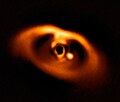
This is a list of extrasolar planets that have been directly observed, sorted by observed separations. This method works best for young planets that emit infrared light and are far from the glare of the star. Currently, this list includes both directly imaged planets and imaged planetary-mass companions (objects that orbit a star but formed through a binary-star-formation process, not a planet-formation process). This list does not include free-floating planetary-mass objects in star-forming regions or young associations, which are also referred to as rogue planets.
Contents
The data given for each planet is taken from the latest published paper on the planet to have that data. In many cases it is not possible to have an exact value, and an estimated range is instead provided. The coldest and oldest planet directly imaged are Epsilon Indi Ab and 14 Herculis c, which have six times Jupiter's mass, an effective temperature of 275 K, an age of about 3.5 Ga and eight times Jupiter's mass, an effective temperature of 275 K, an age of about 4.6 Ga, respectively. This list includes the four members of the multi-planet system that orbit HR 8799.
It is unlikely or at least unclear if objects on a wide orbit (≥100 AU) formed in circumstellar disks and these objects are therefore more often referred as planetary-mass companions. [1] [2] [3] Only in rare cases, such as for HD 106906 b, the formation of the object in the disk is seen plausible.

























































